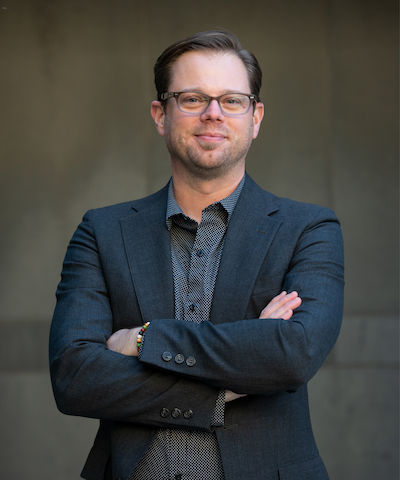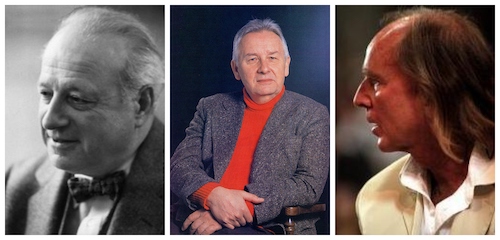by Jarrett Hoffman
FIVE EVENTS TONIGHT:
Two at 7:30, three at 8.
First, Apollo’s Fire and violinist Alan Choo trace the path from Biber to Bach (preview here), and Opera Western Reserve shares a re-imagining of Gounod’s Romeo and Juliet.
Then the Cleveland Pops Orchestra performs a salute to John Williams (preview here), pianist Nicholas Underhill plays Ryan Charles Ramer’s Sonata No. 6 in the presence of art that was inspired by the music, and Oberlin Opera presents Handel’s Acis & Galatea (preview here).
Details in our Concert Listings.
NEW FACES!
The Cleveland Orchestra has announced six new appointments (pictured above). The beginning of this season saw bass section member Derek Zadinsky win the position of assistant principal bass, while Michael Ferraguto joined the ensemble as head librarian, and Amy Zoloto as bass clarinetist and clarinetist. As of this past week, the viola section features a new player in William Bender, to be joined in January by Gareth Zehngut (a COYO alum). And the start of the new year will also bring Charles Paul into the bass section.
Music director Franz Welser-Möst has now appointed nearly half of the current Cleveland Orchestra members.
“Selecting Cleveland Orchestra musicians is the biggest artistic investment we make,” he said in a press release. “In close consultation with a musician panel, I always look for absolutely the best fit, which includes an extremely high standard of musicality for a world-class ensemble. When we pick the best players for a top team, we are not allowed to make a compromise. I’ve heard hundreds of people audition in nineteen years and I am extremely proud of the collaboration with musicians who have advised me so well. When that special person shows up, we all know they are the right person.”
Another warm welcome is in order over at the Contemporary Youth Orchestra, where Kristopher Morron (above) has been named Music Director and Conductor. “This opportunity is like a dream come true,” Morron said in a press release. “I can’t wait to bring all my experience and infectious enthusiasm for music-making to the role.”
Morron comes to CYO with a broad background in music, from his start on the trombone, into the study of jazz at Tri-C and Bowling Green, and into an array of other genres (including funk, experimental folk, New Orleans-style brass, and afrobeat) as a member of several Cleveland-based groups, and as a composer and arranger.
“Our students will benefit from having a person at the podium who understands what it takes to create vastly different kinds of music, including the innovative repertoire we are performing,” said director of educational programming Ben Kipp.
Morron took up the baton beginning in 2004 teaching band and orchestra, received his master’s at Case Western in 2015, and served as a graduate conductor for the Cleveland Youth Wind Symphony. “Music education is about a lot more than the music,” he said. “We’re creating a space where students can be themselves while pursuing excellence as musicians, citizens, and individuals.”
AT THE MET:
The New York Times hails the Met Opera debut of new San Francisco Opera music director Eun Sun Kim (above, who last month became the first woman to inhabit that role in a major American opera company). Reviewing Tuesday’s performance of La Bohème, Anthony Tommasini touches on Kim’s details of tempo, her attention to larger structure, her chemistry with the orchestra, and her sensitive collaboration with singers — while still subtly nudging them along when necessary. “It’s been a long time since I’ve heard Puccini’s score so freshly played,” he writes.
And New York Magazine takes a multifaceted look at Metropolitan Opera general manager Peter Gelb. Shawn McCreesh begins the profile with a colorful portrait of the opera house on opening night of this season, then moves into financial challenges of the past and present, provides a look at the board of directors and at Gelb’s upbringing, details some of the notable decisions he’s made over the course of his tenure, and shares opinions from those who like him — and those who don’t — both within the company and outside it.
TODAY’S ALMANAC:
This date in history brought the “finales,” we could say, of American composer and academic Walter Piston (who died on November 12, 1976), Polish composer Henryk Górecki (who followed suit in 2010), and English composer John Tavener (who in 2013 met his maker — one can assume to a friendly reception, given the composer’s preference for religious choral music).
One of Piston’s greatest pieces is the suite he drew from his ballet The Incredible Flutist — and one performance on YouTube has recently taken on extra relevance to Northeast Ohio. Carlos Kalmar, who joined the CIM faculty in 2021, leads the Spanish Radio and Television Orchestra in a live concert from 2015 at the Teatro Monumental in Madrid.
(As Hathaway wrote in his review of the conductor’s first outing with the CIM Orchestra this past October, “Kalmar showed himself to be a meticulous but expressive presence on the podium.”)
From Górecki, have a listen to his Third Symphony (“Symphony of Sorrowful Songs”). Dedicated to victims of the Holocaust, it was written in 1976 but took fifteen years to make its way into the ears of most listeners outside of Poland, when it also basically introduced the composer to the rest of the world. And it did so with a bang — the London Sinfonietta’s 1992 recording topped the American and British classical music charts, and has continued to rack up sales far beyond what would be expected from similar albums.
Listen to that very recording here, where the orchestra is led by David Zinman, and the soloist is soprano Dawn Upshaw.
As Górecki said in an interview, “Perhaps people find something they need in this piece of music…Somehow I hit the right note, something they were missing…I feel that I instinctively knew what they needed.”
And returning to locally connected recordings — at Trinity Cathedral in 2013, Ross Duffin and Quire Cleveland performed Tavener’s The Lamb, one of the most commercially successful among his renowned religious works.
As Quire points out in the description of the video, “Tavener plays on the innocence of the lamb by featuring only high voices at the beginning…” And though basically the same musical ideas continue, “the doubling of low voices for the second stanza gives a much different musical impression…”
You’ll also enjoy the dissonances, which are decidedly tasty — perhaps something else, aside from the symbolism of a young child and of Jesus, that Tavener had in mind regarding the lamb?







